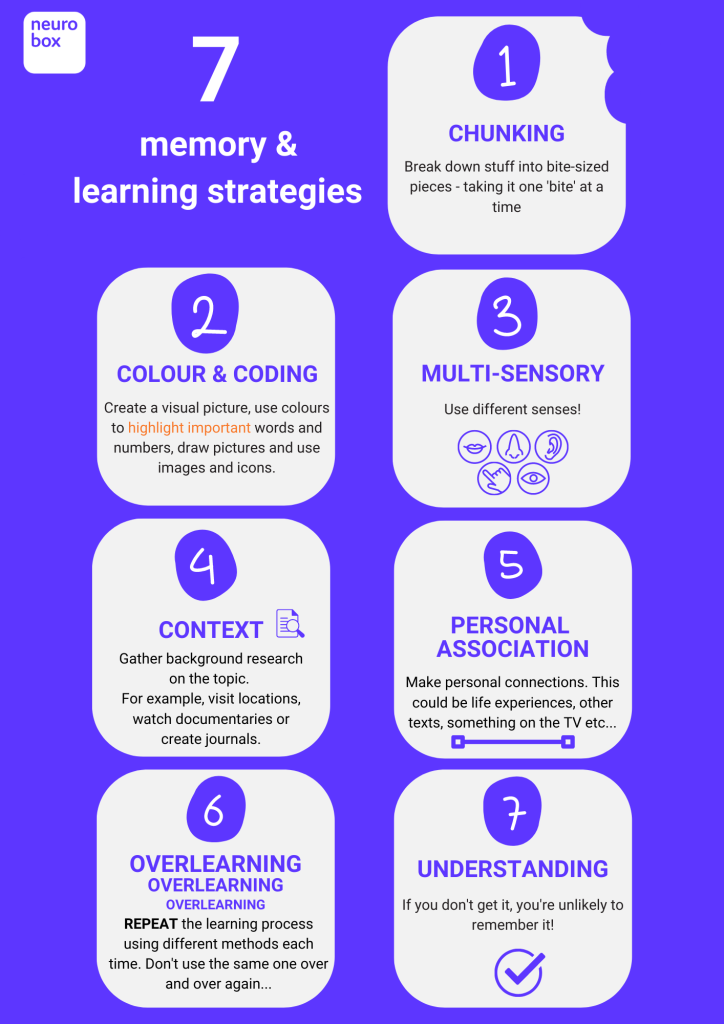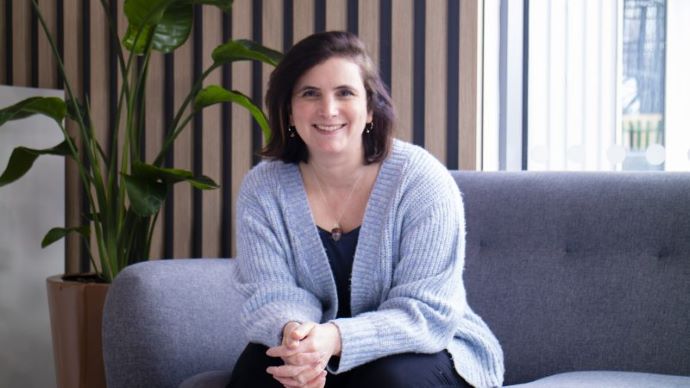Neurobox has previously highlighted how stress can affect us. Another thing which stress can do is reduce our working memory and learning capacity.
Here Deborah Leveroy PhD shares her top memory and learning strategies to support you.
These tips are great for putting into practice in the workplace, or in your general day-to-day life. These can also be good revision tools for students.

1 – Chunking
- Chunking is breaking stuff down into more bite-sized pieces.
- If you’re reading or writing a document, or learning your presentation, break it down into small bits. You could break this down by new paragraph, new idea, or new slide.
2 – Colour and coding
- Create your own masterpiece by turning your text into visual pieces
- You could do this by using colours to highlight words and numbers or using images and icons. To remember the order of a talk, for each new bit of information, draw an image, and create a storyboard – you don’t need to be Picasso – you just need it to make sense to you.
- One of the neurobox team’s favourite things to do is to cover the walls in Post-it notes, using yellow for admin, green for meeting follow-ups and pink for important reminders. Cheaper than buying artwork!
3 – Multi-sensory
- Use different senses to match your learning styles. For example:
- 👁️ Visual learners may find mind mapping and drawings helpful.
- 👂🏻Auditory learners might prefer talking it through. If you’re delivering a presentation, recording your speech, and listening back to it might be beneficial for you.
- 🏃🏻 Kinaesthetic may find it useful to learn and process stuff whilst doing other tasks such as running, washing up – even putting your make-up on!
4 – Context
- Gather background information on the topic to provide context. Don’t come to the task ‘cold’ – do a bit of reading, watching, and thinking about the subject matter beforehand.
- This could include visiting locations, watching documentaries etc…
5 – Personal Associations
- ⚓Personal memories help anchor our memories into our long-term memory.
- Try and connect the thing you’re learning with a personal memory. For example, you could try to attribute it to your life experiences, something you’ve watched on the TV or something in the real world.
6 – Overlearning
- Repetition, Repetition, Repetition! Repeat the learning process but using DIFFERENT methods each time.
- If you’re driving down a road and you come across a road closure, you don’t just keep driving up and down the road, in the hope the road will suddenly become open. No, instead you turn around and find another route. In the same way, you need to process information through different senses as some will work better than others.
7 – Understanding
- Key to memory – if you don’t get it, you’ll probably never remember it! The building block to memory is first understanding what you’re trying to learn.
These strategies are drawn from a variety of sources. Some are cognitive strategies Deborah used with students when she worked as a Study Skills tutor in universities.
However, her approach was honed during her PhD, when she explored the instinctive learning strategies of dyslexic actors. A vital cognitive task of an actor is learning and retrieving tons and tons of lines, that (often), someone else had written.
If you’d like to read more about the strategies and her approach you can read Deborah’s paper – ‘A date with the script, exploring the learning strategies of actors who are dyslexic’.
These experiences are relevant not just to actors, they are applicable to anyone whose work involves processing, memorising, and retrieving information.
Read more Neurobox blogs here
